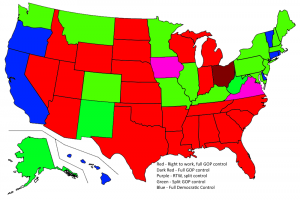I admit, I laughed at this: “If a courageous legislator introduced a repeal [of right-to-work] bill into Congress, unions could demand that their federal representatives support the bill or risk the enactment of state laws protecting workers against arbitrary termination.” It’s from a labor law professor at Colorado State who seems to think that the labor movement can successfully threaten to pass enough state legislation to spark a federal law.
Erm. No.
Let me save you some time with that map: the blue bits are where Big Labor could hope to pass any kind of better-repeal-right-to-work-or-THIS-happens bill. Everywhere else is a big old never-mind. It’s actually remarkable how well right-to-work and full GOP control of the legislature track, at that. Which suggests that Big Labor has made a very, very bad call in deciding to cleave to the Democratic party only… but you all knew that already, too.
That’s pretty much it. Just a reminder that, hey, stuff happens that we like all the time on the state level. The trick is to figure out how to push it upwards, that’s all.


Little children all learn pretty fast that wishing doesn’t make it so. That professor hasn’t.
The map actually suggests something different – that with a little push and a Republican President the opposite could be passed. A national “Right to Work” law with the punitives going the other way.
Although what I’d probably pass instead would give states and unions a choice. They get closed shop or they get political advocacy. They don’t get both, because the combination is too coercive.
At the risk of being seen as giving aid and comfort .. the best thing we could do is neuter Mordor on the Potomac .. but keep it around as it used to be, a place to “promote” useless busybodies to.
.
Mew
I like that the blue areas seem to want to make my red state more enticing to employers (aka wage payers).